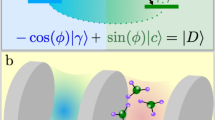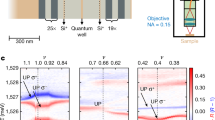Abstract
Cavity–polaritons in semiconductor microstructures have emerged as a promising system for exploring non-equilibrium dynamics of many-body systems1. Key advances in this field, including the observation of polariton condensation2, superfluidity3, realization of topological photonic bands4, and dissipative phase transitions5,6,7, generically allow for a description based on a mean-field Gross–Pitaevskii formalism. Observation of polariton intensity squeezing8,9 and decoherence of a polarization entangled photon pair by a polariton condensate10, on the other hand, demonstrate quantum effects that show up at high polariton occupancy. Going beyond and into the regime of strongly correlated polaritons requires the observation of a photon blockade effect11,12 where interactions are strong enough to suppress double occupancy of a photonic lattice site. Here, we report evidence of quantum correlations between polaritons spatially confined in a fibre cavity. Photon correlation measurements show that careful tuning of the coupled system can lead to a modest reduction of simultaneous two-polariton generation probability by 5%. Concurrently, our experiments allow us to measure the polariton interaction strength, thereby resolving the controversy stemming from recent experimental reports13. Our findings constitute an essential step towards the realization of strongly interacting photonic systems.
This is a preview of subscription content, access via your institution
Access options
Access Nature and 54 other Nature Portfolio journals
Get Nature+, our best-value online-access subscription
$29.99 / 30 days
cancel any time
Subscribe to this journal
Receive 12 print issues and online access
$259.00 per year
only $21.58 per issue
Buy this article
- Purchase on Springer Link
- Instant access to full article PDF
Prices may be subject to local taxes which are calculated during checkout



Similar content being viewed by others
Data availability
The data that support the plots within this paper and other findings of this study are available from the corresponding author upon reasonable request.
References
Carusotto, I. & Ciuti, C. Quantum fluids of light. Rev. Mod. Phys. 85, 299–366 (2013).
Kasprzak et al. Bose–Einstein condensation of exciton polaritons. Nature 443, 409–414 (2006).
Amo, A. et al. Superfluidity of polaritons in semiconductor microcavities. Nat. Phys. 5, 805–808 (2009).
St-Jean, P., Goblot, V., Galopin, E. & Lemaitre., A. Lasing in topological edge states of a one-dimensional lattice. Nat. Photon. 11, 651–656 (2017).
Ohadi, H. et al. Spin order and phase transitions in chains of polariton condensates. Phys. Rev. Lett. 119, 067401 (2017).
Rodriguez, S. R. K. et al. Probing a dissipative phase transition via dynamical optical hysteresis. Phys. Rev. Lett. 118, 247402 (2017).
Fink, T., Schade, A., Höfling, S., Schneider, C. & Imamoğlu, A. Signatures of a dissipative phase transition in photon correlation measurements. Nat. Phys. 14, 365–369 (2018).
Karr, J. Ph, Baas, A., Houdre, R. & Giacobino, E. Squeezing in semiconductor microcavities in the strong coupling regime. Phys. Rev. A 69, 031802(R) (2004).
Boulier, T. et al. Polariton-generated intensity squeezing in semiconductor micropillars. Nat. Commun. 5, 3260 (2014).
Cuevas, A. et al. First observation of the quantized exciton–polariton field and effect of interactions on a single polariton. Sci. Adv. 4, eaao6814 (2018).
Imamoğlu, A., Schmidt, H., Woods, G. & Deutsch, M. Strongly interacting photons in a nonlinear cavity. Phys. Rev. Lett. 79, 1467–1470 (1997).
Verger, A., Ciuti, C. & Carusotto, I. Polariton quantum blockade in a photonic dot. Phys. Rev. B 73, 193306 (2006).
Sun, Y. et al. Direct measurement of polariton–polariton interaction strength. Nat. Phys. 13, 870–875 (2017).
Birnbaum, K. M. et al. Photon blockade in an optical cavity with one trapped atom. Nature 436, 87–90 (2005).
Faraon, A. et al. Coherent generation of non-classical light on a chip via photon-induced tunnelling and blockade. Nat. Phys. 4, 859–863 (2008).
Lang, C. et al. Observation of resonant photon blockade at microwave frequencies using correlation function measurements. Phys. Rev. Lett. 106, 243601 (2011).
Reinhart, A. et al. Strongly correlated photons on a chip. Nat. Photon. 6, 93–96 (2012).
Cubel Liebisch, T., Reinhard, A., Berman, P. R. & Raithel, G. Atom counting statistics in ensembles of interacting rydberg atoms. Phys. Rev. Lett. 95, 253002 (2005).
Urban, E. et al. Observation of Rydberg blockade between two atoms. Nat. Phys. 5, 110–114 (2009).
Ferretti et al. Single-photon nonlinear optics with Kerr-type nanostructured materials. Phys. Rev. B 85, 033303 (2012).
Besga, B. et al. Polariton boxes in a tunable fiber cavity. Phys. Rev. Appl. 3, 014008 (2015).
Diniz, I. et al. Strongly coupling a cavity to inhomogeneous ensembles of emitters: potential for long-lived solid-state quantum memories. Phys. Rev. A 84, 063810 (2011).
Houdré, R., Stanley, R. P. & Ilegems, M. Vacuum-field Rabi splitting in the presence of inhomogeneous broadening: resolution of a homogeneous linewidth in an inhomogeneously broadened system. Phys. Rev. A 53, 2711–2715 (1996).
Muñoz-Matutano, G. et al. Emergence of quantum correlations from interacting fibre-cavity polaritons. Nat. Mater. https://doi.org/10.1038/s41563-019-0281-z (2019).
Ferrier, L. et al. Interactions in confined polariton condensates. Phys. Rev. Lett. 106, 126401 (2011).
Rodriguez, S. R. K. et al. Interaction-induced hopping phase in driven-dissipative coupled photonic micro-cavities. Nat. Commun. 7, 11887 (2016).
Togan, E., Lim, H.T., Faelt, S., Wegscheider, W. & Imamoğlu, A. Strong interactions between dipolar polaritons. Phys. Rev. Lett. 121, 227402 (2018).
Rosenberg, I. et al. Strongly interacting dipolar-polaritons. Sci. Adv. 4, eaat8880 (2018).
Ravets, S. et al. Polaron polaritons in the integer and fractional quantum Hall regimes. Phys. Rev. Lett. 120, 057401 (2018).
Boulier, T. et al. Polariton-generated intensity squeezing in semiconductor micropillars. Nat. Commun. 5, 3260 (2014).
Acknowledgements
This work was supported by the Swiss National Science Foundation (SNSF) through a DACH project 200021E-158569-1, SNSF National Centre of Competence in Research – Quantum Science and Technology (NCCR QSIT) and an ERC Advanced investigator grant (POLTDES). The Würzburg Group acknowledges support by the state of Bavaria, and the DFG within project SCHN1376-3.1.
Author information
Authors and Affiliations
Contributions
A.D., T.F. and A.I. supervised the project. T.F. designed the experiment. A.D. and T.F. carried out the measurements. A.S., C.S., and S.H. grew the sample. A.D. and A.I. wrote the manuscript.
Corresponding author
Ethics declarations
Competing interests
The authors declare no competing interests.
Additional information
Publisher’s note: Springer Nature remains neutral with regard to jurisdictional claims in published maps and institutional affiliations.
Supplementary information
Supplementary Information
Supplementary Sections 1–4, Supplementary Figures 1–4, Supplementary References 1–5
Rights and permissions
About this article
Cite this article
Delteil, A., Fink, T., Schade, A. et al. Towards polariton blockade of confined exciton–polaritons. Nature Mater 18, 219–222 (2019). https://doi.org/10.1038/s41563-019-0282-y
Received:
Accepted:
Published:
Issue Date:
DOI: https://doi.org/10.1038/s41563-019-0282-y
This article is cited by
-
Probing many-body correlations using quantum-cascade correlation spectroscopy
Nature Physics (2024)
-
Nonlinear Rydberg exciton-polaritons in Cu2O microcavities
Light: Science & Applications (2024)
-
Qubit gate operations in elliptically trapped polariton condensates
Scientific Reports (2024)
-
Deterministic entangling gates with nonlinear quantum photonic interferometers
Communications Physics (2024)
-
Local tuning of Rydberg exciton energies in nanofabricated Cu2O pillars
Communications Materials (2024)



